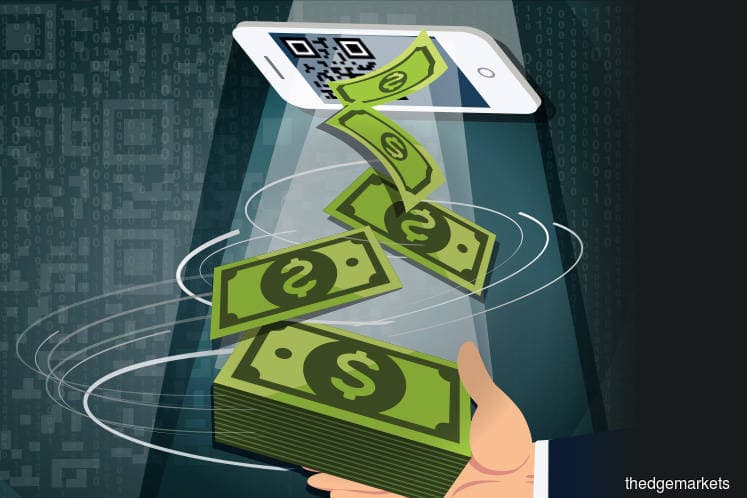
This article first appeared in The Edge Malaysia Weekly on August 14, 2017 - August 20, 2017
IF you can’t beat them, join them.
CIMB Group Holdings Bhd appears to have embraced this philosophy by partnering its subsidiary, Touch ’n Go Sdn Bhd, with Ant Financial Services Group — the parent company of Alipay.
But not every bank will have the opportunity or the resources to enter the payments race. As in the case of China, there is only room for a couple of big players.
So, what does this mean for banks that are unable to go into the fintech space?
Well, it may sting a little, but certainly will not be their undoing.
“All payment operators need a bank as an end point. To download money to eWallet, we need a bank. Of course, once money is in the eWallet, we can bypass the banks for P2P (person-to-person) transactions. There will be some impact on the banks, but these are small-value and high-volume transactions ... something the banks can happily not process,” says United Overseas Bank (M) Bhd executive director and country head of technology and operations Lum Chee Onn.
He argues that conventional consumer banking products like housing loans and hire purchase should remain relatively intact. Such lending will require licences from Bank Negara Malaysia and ample capital.
In fact, it is important to dispel the notion that the banking system will lose deposits.
“E-money schemes are required to place funds collected from customers into a trust account maintained by the bank. The funds in the trust accounts can only be used for a specific purpose — to provide refunds to users or pay merchants,” explains Bank Negara’s director of payment systems policy department, Tan Nyat Chuan.
He points out how Touch ’n Go places its customers’ funds in trust accounts.
This is because e-money licences do not allow for deposit-taking — something that requires a deposit-taking licence from the central bank. In other words, something only banks can do, currently and in the foreseeable future.
That said, both Ant Financial and Tencent have attempted to become banks in China. They ventured into online-only banks, which accepted interest-bearing deposits. However, Chinese regulators have since clamped down on such accounts, placing an upper limit on balances in such accounts.
In Malaysia, the regulatory restrictions are even tighter. Any payment operator hoping to start an online-only bank would be subject to incredibly stringent prudential requirements.
Thus, the overall liquidity of Malaysia’s banking system should not be affected, although deposits may flow from one bank to another, depending on how attractive the deposit rates are.
But what about banks’ revenue? Will they lose credit-card and other payment-related incomes?
The recurring income from credit cards is certainly an attractive revenue stream for banks. In this regard, Bank Negara’s Payment Card Reform Framework (PCRF) is already chipping away at banks’ earnings.
“The PCRF is a huge disruption to the payment card ecosystem. Under the PCRF, merchants are empowered to choose the lower cost payment card network. In this regard, competition is likely to shift from the issuing side to the acquiring side of the payment card business,” explains Tan.
It is also important to note that interchange fees, which are what Bank Negara is compressing for banks, only make up 16% of banks’ credit card income.
Other incomes like late fees and interest charges make up the bulk of banks’ credit card business.
Furthermore, some market players do not even expect fintech competition to be a big problem.
“New payment modes that enter the market may be cheaper and more cost-efficient. But they will not prioritise top-tier merchants that are currently in the credit card ecosystem,” explains Perry Ong, Mastercard’s country manager for Malaysia and Singapore.
He argues that QR-code-based mobile payment operators will focus on the lower-tier merchants that could not afford the conventional payment infrastructure in the first place.
“Think about it like concentric rings. We are in the centre, the top-tier and second-tier merchants and we are expanding outwards. They are on the outside, expanding inwards,” Ong explains.
At the end of the day, consumers want security and speed, he says, something that they are already getting with conventional payment cards.
Furthermore, Ong points out that Mastercard is a technology company at its core and has been actively investing in research and development as well as acquiring new technologies.
For example, Mastercard has partnered Apple and Samsung for their respective wallets — Apple Pay and Samsung Pay. On top of that, the group is looking into new applications of QR-code technology, he says.
But the technology alone is not what gives mobile payment operators an advantage.
From a business perspective, Lum concedes that banks may not be prepared to go head-to-head with an aggressive fintech start-up, especially one that is fuelled by venture capital and willing to operate at a loss.
Just look at the kind of money companies like Uber and Grab are willing to spend in order to gain market share. Other than aggressive marketing, a new payment operator is likely to subsidise users to gain traction and grow market share. Banks may not be willing to do the same.
“Banks are more conservative since they have to answer to shareholders. In this regard, well-funded start-ups may have the advantage. Of course, there is only so much money they can burn. At the end of the day, all investors want to make money,” says Lum.
Save by subscribing to us for your print and/or digital copy.
P/S: The Edge is also available on Apple's AppStore and Androids' Google Play.